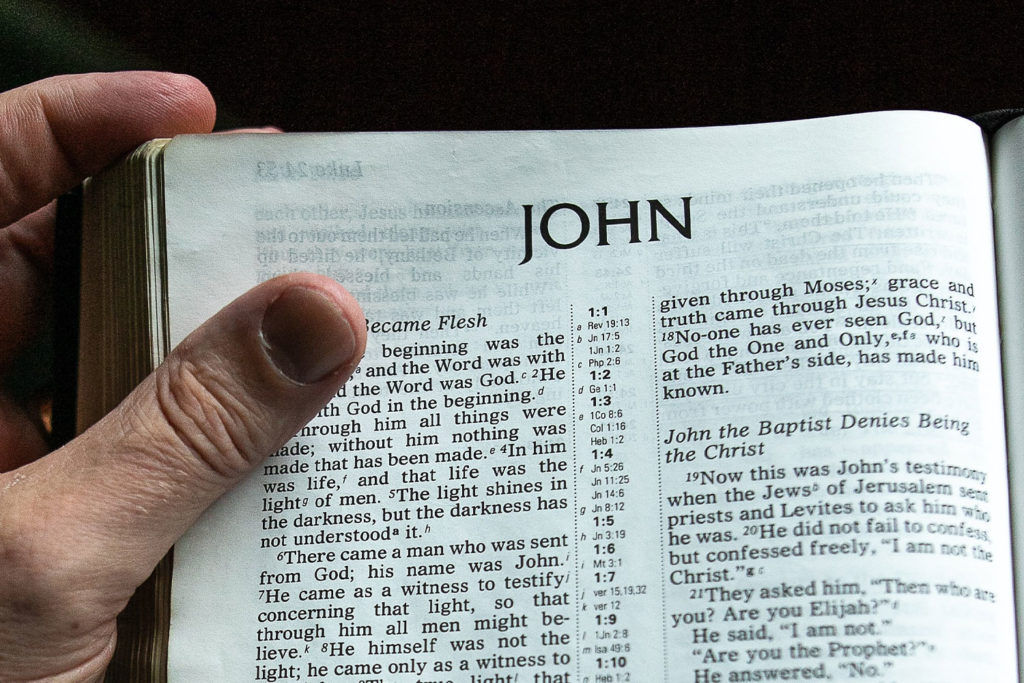By Craig L. Blomberg
Of the four New Testament Gospels, the one that least resembles the other three is the Gospel of John. While some of those most skeptical Gospel scholars dismiss all four as fairly untrustworthy, many are willing to give significant credence to the Synoptics (Matthew, Mark and Luke) but still doubt that more than a small handful of details of the fourth Gospel can be deemed historical. After all, John alone contains the miracle of Jesus turning water into wine or the resurrection of Lazarus; the three-year framework for Jesus’ ministry, including numerous visits to Jerusalem at festival time replete with unique challenges to the Jewish leaders; a series of claims about Jesus’ identity that virtually equate him with God and make more explicit self-disclosures more consistently than anything we find in the other three canonical accounts. Numerous other differences emerge as well: John contains none of the parables or exorcisms characteristic of the Synoptics, but does have consistently longer discourses of Jesus than are found in those earlier Gospels. Overall, both in the total number of passages included and in the particular details John chose to include in otherwise paralleled passages, the fourth Gospel more commonly goes its separate way. And at many points the language of John the narrator and that of Jesus the speaker seems identical. In light of all these differences, can the overall credibility of John be salvaged in any way? Fourteen arguments converge to suggest an affirmative answer.
(1) One of the reasons John seems so different is because Matthew, Mark and Luke are related to one another at a literary level. Despite important distinctives, their accounts are more similar than dissimilar because Matthew and Luke adopted in general Mark’s overall outline and selection of passages, while supplementing them as well. John is different because, literarily, he is largely independent of the Synoptics. In terms of weighing rather than counting witnesses, it’s really more a case of one versus one, not three versus one. John 21:25 may reflect hyperbole, but it reminds us that had four entirely independent Gospels been penned, they might have all diverged from one another as much as John does from Mark and company.
(2) Although John does not follow any other Gospel with enough verbal parallelism to suggest literary borrowing, he would have known the broad “table of contents” of what the Synoptics contained and almost certainly decided to supplement their portraits of Jesus with information he felt too important to leave out of any Gospel, rather than providing just one more take on episodes that had already been recorded one, two or three times.
(3) The Synoptics have every bit as much theological interest and thematic structure as John, so where the two versions of Jesus’ life differ we cannot automatically assume it is John’s version that is inferior. Indeed, it appears that Mark wanted to narrate only one climactic trip by Jesus to Jerusalem at the Passover, during which he was crucified. When Matthew and Luke followed him in this respect, by definition they excluded all opportunity for narrating Jesus’ teaching and conflict with the authorities during other forays to the Jewish capital or miracles that happened en route during one of those trips to or from Jerusalem, including the resurrection of Lazarus.
(4) The distinctive churches or Christian communities to which each Gospel was written account for some of the unique selections that their writers made regarding what to include. John appears to have been written by the aged apostle in the 90s to congregations in and around Ephesus at a time of emerging Gnosticism and increasing exclusion of Christian Jews from local synagogues. The twin emphases on the deity and humanity of Christ, against challenges to one or the other of these beliefs by these two groups, along with the strong polemic against key Jewish leaders, fits this unique context of addressees.
(5) In a world that had not yet invented a symbol for a quotation mark nor had any felt-need for one, it was entirely acceptable to paraphrase a speaker’s words in one’s own style without sharply distinguishing between the styles of speaker and narrator. That John testified to being inspired by the Holy Spirit (one probable implication of John 14:26 and 15:26) would have actually increased the freedom he felt to use his own style more than Jesus’ literal wording, because he believed that God was guiding him to say the right things anyway. At the same time, it is worth pointing out that the style is not quite as uniform throughout the Gospel as some have suggested. There are in fact 145 words used by Jesus in the Gospel of John found nowhere else in the document.
(6) Several of Jesus’ longer “sermons” in John closely approximate standard rabbinic forms of discourse, lending plausibility to the notion that Jesus the Jew might have actually preached that way. It is inconceivable that Jesus only went around uttering the short, pithy proverbs and parables ascribed to him in the Synoptics; in fact, those gospels, too, present longer sermons (most famously the Sermon on the Mount), which show signs of careful organization.
(7) The fourth Gospel actually presents a much more consistently chronological account of Jesus’ ministry, even though that emerges not as a primary intention but as a “fringe benefit” of its desire to include material from Jesus attending the various Jerusalem festivals (which can be dated). And the claims Jesus makes for himself at each of those festivals dovetail closely with the significance of the festivals-Bread of Life at Passovertime, working as the Father does on the Sabbath, Light of the World and living water at Tabernacles, the Good Shepherd at Hanukah, and so on. John likewise contains more details of geography and topography than any of the Synoptics and, where he can be tested, he has consistently been shown to be accurate.
(8) Themes like “witness” and “truth” are central to the fourth Gospel. Repeatedly, the editor of the final form of the gospel refers to beloved disciple (traditionally understood to be John) and puts his “imprimatur” on the document at the end by insisting that the Gospel came from this disciple, whose testimony is true (John 21:24). It is hard to square these repeated emphases with claims that John was largely writing historical fiction, or worse.
(9) We must avoid overestimating the differences between John and the Synoptics. Numerous events are held in common by the two traditions, the overlapping ministries of Jesus and John the Baptist, the healing of a ruler’s servant, the feeding of the 5,000, the walking on the water, the triumphal entry, and Jesus’ arrest, passion, crucifixion, and resurrection. Some of John’s omissions make sense given his largely Gentile-Christian audience. Parables were an almost exclusively Jewish form of teaching, while exorcisms bordered on the “magical” in the Greco-Roman world. As for John’s lofty claims for Jesus as the very Word of God, we must remember that it is Matthew and Luke who recount the virginal conception, a pointer to an equally spectacular origin; that all four Gospels have Jesus speaking of himself as being sent by God in a fashion that suggests pre-existence, and that the Synoptics’ Jesus says, literally, “Fear not, I am” during the walking on the water, akin to the absolute, “Before Abraham was, I am” of John 8:58. Conversely, texts like John 8:25, 10:25 and 16:29 all point out how even Jesus’ closest followers thought there was a cryptic, perhaps even parabolic dimension to his speech in the fourth Gospel that did not reflect unambiguously “high Christology” even right up to the last night of his life.
(10) In a whole spate of instances, information found only in John explains otherwise puzzling silences in the Synoptics and vice-versa, creating an “interlocking” between the two traditions unlikely to have been invented. Matthew 23:37 describes Jesus often lamenting over Jerusalem how she was unwilling to follow him, when only John depicts him going to town more than once. Mark 14:58-59 refers to a garbled accusation that Jesus had threatened to destroy the temple, which fits only John 2:19, among canonical accounts. On the other hand, John’s passing reference to John the Baptist’s imprisonment (John 3:24) cries out for some narrative elaboration of the kind found only in the Synoptics (e.g., Mark 6:14-29). So, too, the highly abbreviated references to Jesus’ trial before Caiaphas in John 18:24 and 28 presuppose knowledge of accounts like those unique to Matthew, Mark and Luke (e.g., Mark 14:53-65).
(11) Several texts in John explicitly distinguish what the disciples understood only after Jesus’ resurrection from how they reacted on the spot to various teachings of Jesus in ways that suggest John was going out of his way to record only the amount of understanding that people had during Jesus’ life and not to merge later insight with earlier history. See especially John 2:22, 7:39, 12:16 and 16:12-13.
(12) The overall literary genre of John, while still more like the other three Gospels than like any other known genre of antiquity, does have numerous touches of Greco-Roman drama-a valid genre for retelling historical events but one which by definition does give writers more artistic license in the way scenes are framed, characters are portrayed, eras of history are stylized, and the like.
(13) Almost every unparalleled passage in John nevertheless contains some striking similarity to something that does occur in the Synoptic Gospels. The similarities may involved the central content (e.g., the healing of a paralytic or a blind man), a miracle that matches a parable (e.g., water into wine compared with the parable of the wineskins); a key theme (e.g., ministry to outcasts such as Samaritans and women) or parallels between elements of a large discourse in John and individual sayings in the Synoptics (e.g., “you must be born again” in the longer exchange between Jesus and Nicodemus in John 3 and “unless you become like a little child. . .” in Matt. 18:3).
(14) Occasionally, unparalleled material in John will find verisimilitude in what we know from rabbinic traditions. The ben Gurion family, with several generations of leaders named Nicodemus, was very wealthy and powerful. Caiaphas built a reputation for being particularly wicked and changing long-cherished traditions by his own people, including introducing sacrificial animals and money changing into the very temple precincts themselves. Other unique details match what we know from Jewish or Roman historians-taking the death penalty away from the Sanhedrin in most instances or Annas as a high priest being considered to hold the office of life, and thus still honored by being consulted, even after Rome had officially deposed him.
Not surprisingly, a considerable number of scholars during the last half-century have pioneered what came to be known as the “new look on John,” recognizing a far greater level of historical reliability and a Jewish milieu for the deeds and teachings attributed to Jesus than the first half of the twentieth century had acknowledged. Arguably, if the next half-century gave the same kind of sustained study to the remaining questionable details, the amount of general confidence in the fourth Gospel would again grow in corresponding fashion.
Published March 30, 2016




